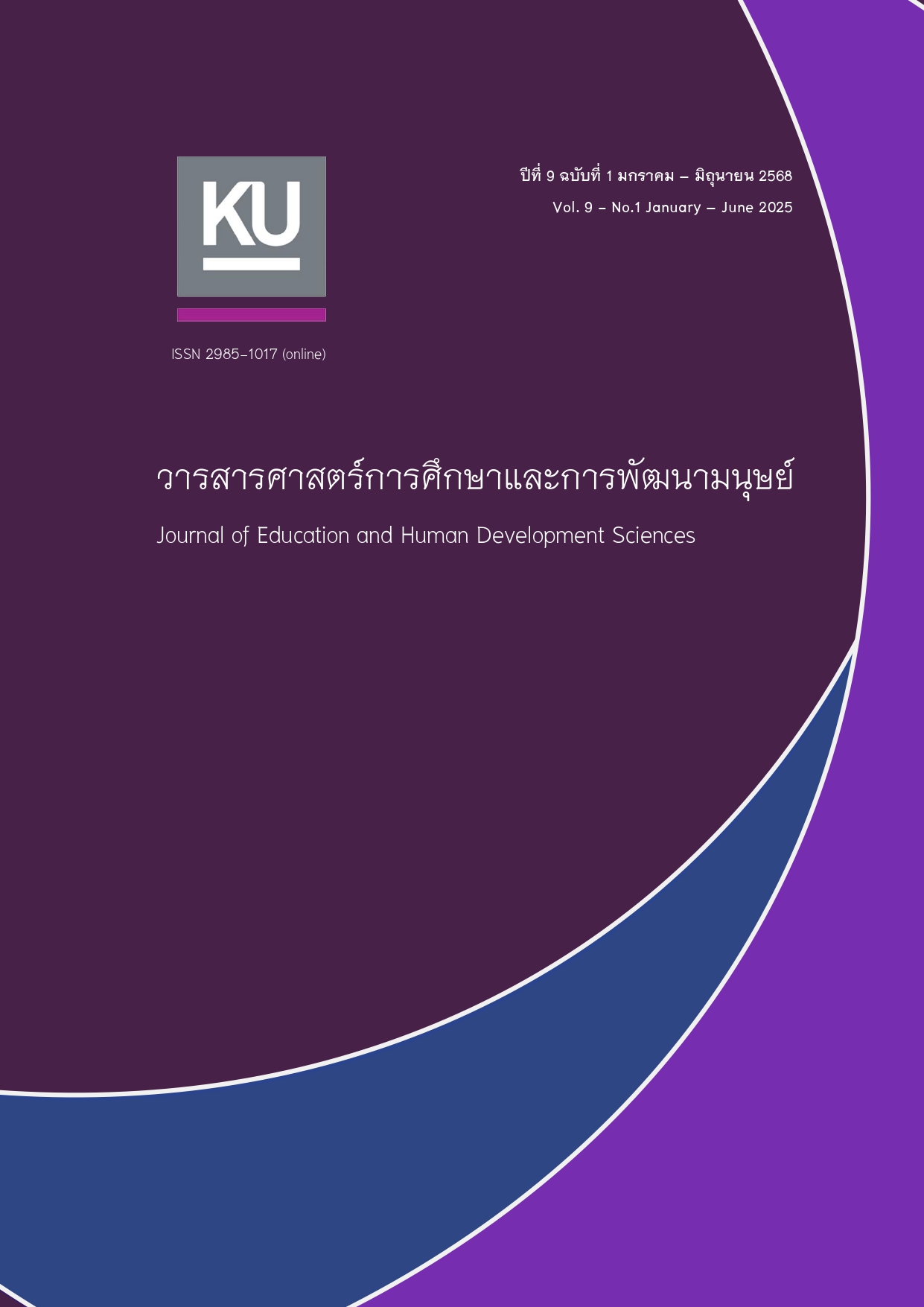การพัฒนารูปแบบการเรียนการสอนแบบผสมผสานด้วยเทคโนโลยีด้านการศึกษาตามแนวคิดการเรียนรู้เชิงรุก เพื่อสร้างแรงจูงใจทางการเรียนของนักเรียน
##plugins.pubIds.doi.readerDisplayName##:
https://doi.org/10.56825/jehds.2025.915912关键词:
เทคโนโลยีด้านการศึกษา, การเรียนรู้แบบผสมผสาน, การเรียนรู้เชิงรุก摘要
การวิจัยในครั้งนี้มีวัตถุประสงค์เพื่อ 1) เพื่อศึกษาสภาพปัญหาในการจัดการเรียนการสอนของโรงเรียนคลองแดนวิทยา 2) เพื่อพัฒนารูปแบบการเรียนการสอนแบบผสมผสานด้วยเทคโนโลยีด้านการศึกษาตามแนวคิดการเรียนรู้เชิงรุก เพื่อสร้างแรงจูงใจใฝ่สัมฤทธิ์ทางการเรียน และ 3) เพื่อศึกษาผลการใช้รูปแบบการเรียนการสอนแบบผสมผสานด้วยเทคโนโลยีด้านการศึกษาตามแนวคิดการเรียนรู้เชิงรุก เพื่อสร้างแรงจูงใจใฝ่สัมฤทธิ์ทางการเรียน โดยกลุ่มตัวอย่างที่ใช้ทดลองคือ นักเรียนชั้นมัธยมศึกษาปีที่ 2/1 โรงเรียนคลองแดนวิทยา อำเภอระโนด จังหวัดสงขลา รายวิชาเทคโนโลยี(วิทยาการคำนวณ) รหัสวิชา ว22104 เรื่อง ระบบคอมพิวเตอร์และเทคโนโลยีการสื่อสาร เครื่องมือในการวิจัย ประกอบด้วย 1) รูปแบบการเรียนการแบบผสมผสานด้วยเทคโนโลยีด้านการศึกษาตามแนวคิดการเรียนรู้เชิงรุก เพื่อสร้างแรงจูงใจใฝ่สัมฤทธิ์ทางการเรียน 2) แผนการจัดการเรียนรู้ 3) แบบวัดแรงจูงใจใฝ่สัมฤทธิ์ทางการเรียน 4) แบบสังเกตพฤติกรรมแรงจูงใจใฝ่สัมฤทธิ์ทางการเรียน และ 5) แบบสอบถามความพึงพอใจ สถิติที่ใช้ ได้แก่ ค่าเฉลี่ย ส่วนเบี่ยงเบนมาตรฐาน ความแตกต่างของระดับแรงจูงใจใฝ่สัมฤทธิ์ทางการเรียน (T-test dependent) และค่าสัมประสิทธิ์ความเชื่อมั่น(Reliability)
ผลการวิจัยพบว่า
1) สภาพปัญหาในการจัดการเรียนการสอนของโรงเรียนคลองแดนวิทยา พบว่า นักเรียนเบื่อหน่าย ไม่มีความกระตือรือร้นในการเรียนการสอน ไม่สนใจ ไม่มีสมาธิกับบทเรียน ขาดแรงจูงใจในการเรียน ไม่มีส่วนร่วมในกิจกรรมการเรียนการสอน
2) การพัฒนารูปแบบการเรียนการสอนแบบผสมผสานด้วยเทคโนโลยีด้านการศึกษาตามแนวคิดการเรียนรู้เชิงรุก เพื่อสร้างแรงจูงใจใฝ่สัมฤทธิ์ทางการเรียน ความเหมาะสมของรูปแบบการเรียนการสอนอยู่ในระดับมากที่สุด (= 4.54 S.D. = 0.48) กิจกรรมการเรียนการสอนประกอบด้วย 5 ขั้นตอน คือ ขั้นที่ 1 สร้างสติ(Consciousness) ขั้นที่ 2 สร้างสำคัญ(Important content) ขั้นที่ 3 สร้างเสาะแสวง(Discovery) ขั้นที่4 สร้างสรรค์ (Style creation) และ ขั้นที่ 5 สร้างสะท้อน (Evaluation and Reflection)
3) นักเรียนมีระดับแรงจูงใจใฝ่สัมฤทธิ์ทางการเรียนหลังเรียน (= 4.01 S.D. = 0.64) สูงกว่าก่อนเรียน (= 2.92 S.D. = 0.57) อย่างมีนัย สำคัญทางสถิติที่ระดับ .05
4) นักเรียนมีความพึงพอใจต่อการเรียนการสอนด้วยรูปแบบการเรียนการสอน ในภาพรวมอยู่ในระดับมาก (= 4.28 S.D. = 0.64)
##plugins.generic.usageStats.downloads##
参考
Boriboon, S. (2021). Meditation : With solving students unwanted problems. Srilangchang Research Journal, 1(2), 35–50. [translated]
Dusai, Y., Siriwan, I., & Chamnisat, B. (2019). Motivation Strategies for Learning of Elementary School Students in Bangkok Educational Institutions. Journal of MCU Nakhondhat, 6(3), 1380–1395. [translated]
Fongjangwang, S., & Kongmanus, K. (2017). The Development of Blended Instructional Model by Using Cooperative Learning in Basic JavaScript Language Programming for Mathayom Suksa 3 Students. Journal of Community Development Research(Humanities Ans Social Sciences), 10(4), 121–133. [translated]
Keawmanee, N. (2019). A study of learning achievement in learning area of occupations and technology and creative thinking ability of grade 9 students using project-based learning approach. Valaya Anongkorn Rajabhat University under the Royal Patronage Pathum Thani. [translated]
Khampa, M. (2019). Development of Visual Art Product creating by Using Discovery Learning for Lower Secondary School Students. Dhurakij Pundit University. [translated]
Klongdaenwittaya School. (2022). Self Assessment Report :SAR of Klongdaenwittaya School. [translated]
Ministry of Education. (2017). Thailand education scheme in brief 2017-2036 (1th ed.). Prigwhan. [translated]
Phitchaya and Lincharoen, A. D. (2017). A Development Approach for Assessment Learning and Innovation Skills Using Assessment of Learners Method in 21 st Century. Journal of Community Development Research (Humanities and Social Sciences), 2(10), 139–153. [translated]
Phuriwikrai K.(2022). World education in the 21st century: systems still inequitable Learning is still
in crisis. Equitable Education Fund (EEF). https://www.eef.or.th/global-education/.[translated]
Prachyapruit, A. (2018). Development of Teacher preparation Model to Serve Education 4.0. Journal Romphruek, 35(3), 102–132. [translated]
Pumsanthia, P., Charoenchob, S., Meesup, P., & Voravitrattanakul, P. (2020). The Development of Augmented Reality on Chinese Language Learningfor Tenth Grade Students. Journal of Education Studies, 48(2), 184–202. [translated]
Taraporn, T., Lamlaor, A., & Rungruangsuparat, B. (2020). Blended Learning Approach and the Future of Education Management in New Normal Society. Journal of Liberal Arts RMUTT, 1(1), 25–39. [translated]
The Institute for the Promotion of Teaching Science and Technology (IPST). (2023). conference of PISA 2022. https://pisathailand.ipst.ac.th/news-21/ .[translated]
Wangkid, M., Onming, R., & Kasemnet, L. (2017). Development of instructional model for information
technology focused on self-directed learning in flipped learning with grade seven students.
Phranakhon Rajabhat Research Journal (Humanities and Social Sciences), 12(1), 190–204.
[translated]
Wanichanan, P. (2023). TDRI points out that the PISA test results send a warning message that
the Thai education system has problems that make Thai people unprepared to cope with a changing
world. https://tdri.or.th/2023/12/pisa-2022/. [translated]
##submission.downloads##
已出版
期
栏目
##submission.license##
##submission.copyrightStatement##
##submission.license.cc.by-nc-nd4.footer##






